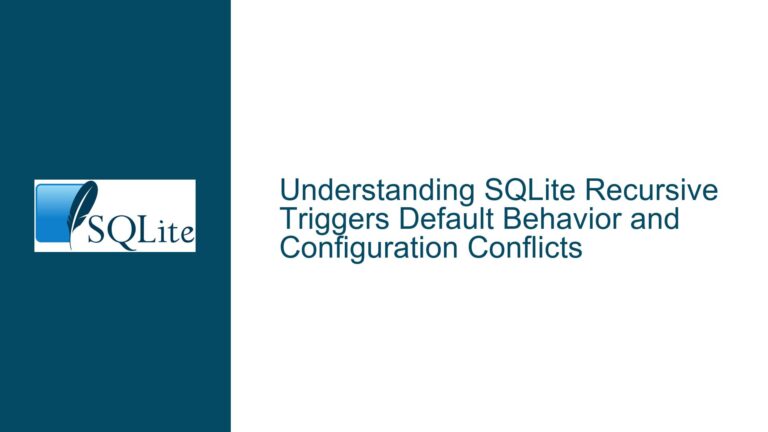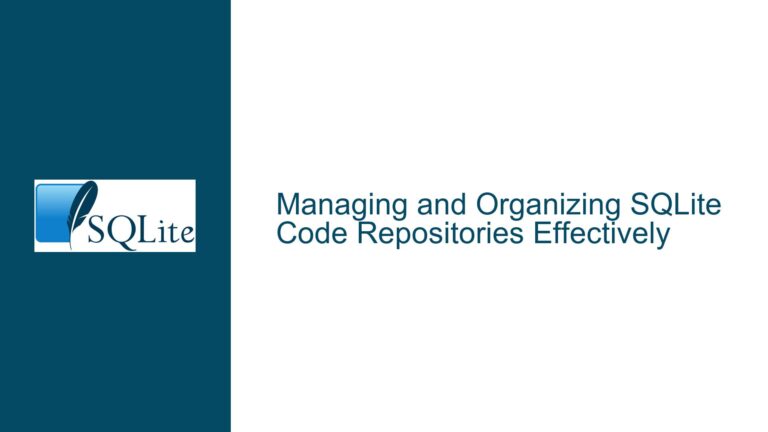Resetting SQLite Session Changesets Without Recreating Sessions
Understanding the Need for Session Reset in SQLite Session Extension
The SQLite Session Extension is a powerful tool for tracking changes in a database over time, enabling synchronization between multiple database instances. However, one of the challenges developers face is the inability to reset a session’s changeset without deleting and recreating the session. This limitation becomes particularly cumbersome in applications where changesets need to be generated frequently, such as in real-time data synchronization or incremental backup systems.
When a session is created using sqlite3session_create, it begins tracking changes to the specified tables. The sqlite3session_changeset function generates a changeset, which is a binary representation of the changes made since the session was created or last reset. However, calling sqlite3session_changeset does not reset the session; it continues to accumulate changes. This behavior is by design, as sessions are intended to track changes over an extended period, potentially spanning multiple transactions.
The current workaround involves deleting the session using sqlite3session_delete, recreating it with sqlite3session_create, and reattaching the tables with sqlite3session_attach. This process is not only inefficient but also introduces unnecessary complexity, especially in applications where changesets need to be generated frequently. The core issue, therefore, is the lack of a built-in function to reset a session’s changeset without deleting and recreating the session.
Exploring the Limitations and Challenges of Manual Session Reset
Given the absence of a built-in sqlite3session_reset function, developers have attempted to implement their own solutions. One such approach involves manually clearing the internal data structures that track changes within the session. Specifically, this involves iterating over the pTab->apChange array, which stores the changes for each table, and freeing the associated memory. While this approach seems straightforward, it is fraught with challenges.
The primary challenge lies in the complexity of the internal data structures used by the SQLite Session Extension. The SessionTable structure, which represents a table being tracked by the session, contains multiple layers of nested data. Each SessionTable has an apChange array, which points to a linked list of SessionChange structures. Each SessionChange structure, in turn, contains pointers to the next change in the list. Manually freeing these structures requires careful navigation of the linked lists and proper handling of memory deallocation to avoid memory leaks or corruption.
Another challenge is ensuring that the session is left in a consistent state after the reset. Simply clearing the apChange array and setting nEntry and nChange to zero may not be sufficient. There may be other internal state variables or data structures that need to be reset to ensure that the session behaves correctly after the reset. Without a deep understanding of the internal workings of the SQLite Session Extension, it is easy to introduce subtle bugs that only manifest under specific conditions.
Furthermore, the lack of documentation on the internal data structures and their relationships adds to the difficulty. While the SQLite source code is open and can be inspected, it is not always easy to determine the correct way to manipulate these structures. This is particularly true for developers who are not intimately familiar with the SQLite codebase.
Implementing a Robust Solution for Session Reset
To address the challenges outlined above, a robust solution for resetting a SQLite session’s changeset without deleting and recreating the session must be developed. This solution should be based on a thorough understanding of the internal data structures and their relationships, as well as the intended behavior of the session extension.
The first step in implementing a session reset function is to carefully analyze the SessionTable and SessionChange structures. The SessionTable structure contains the apChange array, which is a dynamically allocated array of pointers to SessionChange structures. Each SessionChange structure represents a single change to a row in the table and contains pointers to the next change in the list. To reset the session, all SessionChange structures must be freed, and the apChange array must be cleared.
The following code snippet demonstrates a potential implementation of a sqlite3session_reset function:
void sqlite3session_reset(sqlite3_session *pSession) {
sqlite3 *db = pSession->db;
SessionTable *pNext;
SessionTable *pTab;
for (pTab = pSession->pTable; pTab; pTab = pNext) {
int i;
pNext = pTab->pNext;
for (i = 0; i < pTab->nChange; i++) {
SessionChange *p;
SessionChange *pNextChange;
for (p = pTab->apChange[i]; p; p = pNextChange) {
pNextChange = p->pNext;
sessionFree(pSession, p);
}
}
pTab->nEntry = pTab->nChange = 0;
sessionFree(pSession, pTab->apChange);
}
}
In this implementation, the function iterates over each SessionTable in the session, freeing all SessionChange structures and clearing the apChange array. The nEntry and nChange fields are also reset to zero to indicate that no changes are currently being tracked.
However, as noted earlier, this implementation may not be sufficient to ensure that the session is left in a consistent state. Additional steps may be required to reset other internal state variables or data structures. For example, the session may maintain a list of tables that have been modified, or it may have other internal bookkeeping structures that need to be reset.
To ensure the robustness of the sqlite3session_reset function, it is essential to thoroughly test the implementation under various conditions. This includes testing with different types of changes (inserts, updates, and deletes), with multiple tables, and with concurrent sessions. Any inconsistencies or unexpected behavior should be carefully analyzed and addressed.
In addition to testing, it is also important to consider the potential impact of the sqlite3session_reset function on other parts of the SQLite Session Extension. For example, if the session is reset while a changeset is being generated, it could lead to undefined behavior. Therefore, the sqlite3session_reset function should be designed to handle such edge cases gracefully.
Finally, it is worth considering whether the sqlite3session_reset function should be added to the official SQLite API. While the current implementation provides a workaround for the lack of a built-in reset function, it is not a long-term solution. Adding a sqlite3session_reset function to the official API would provide a more robust and maintainable solution for developers who need to reset sessions without deleting and recreating them.
In conclusion, resetting a SQLite session’s changeset without deleting and recreating the session is a complex task that requires a deep understanding of the internal data structures and their relationships. While it is possible to implement a custom sqlite3session_reset function, care must be taken to ensure that the session is left in a consistent state and that the function behaves correctly under all conditions. Thorough testing and careful consideration of edge cases are essential to developing a robust solution. Additionally, adding a sqlite3session_reset function to the official SQLite API would provide a more maintainable and reliable solution for developers.






